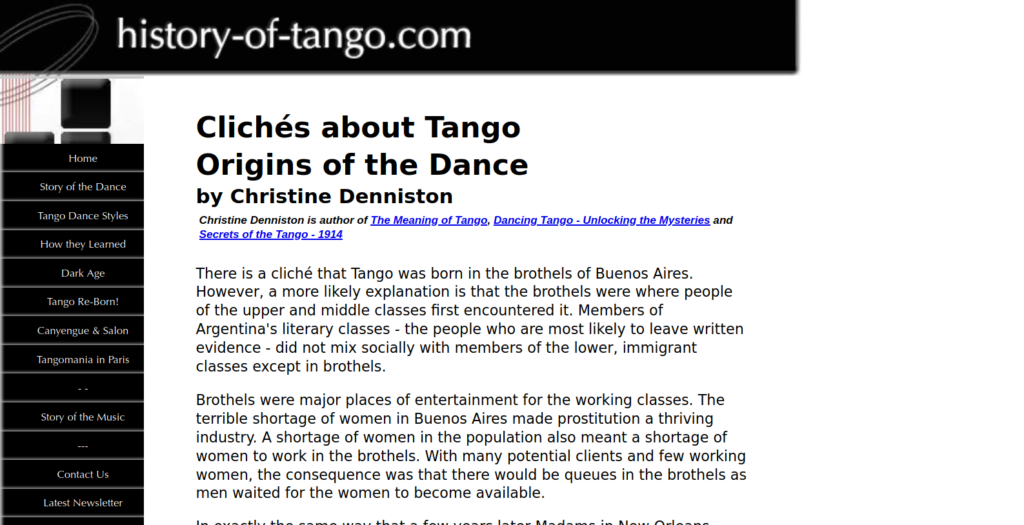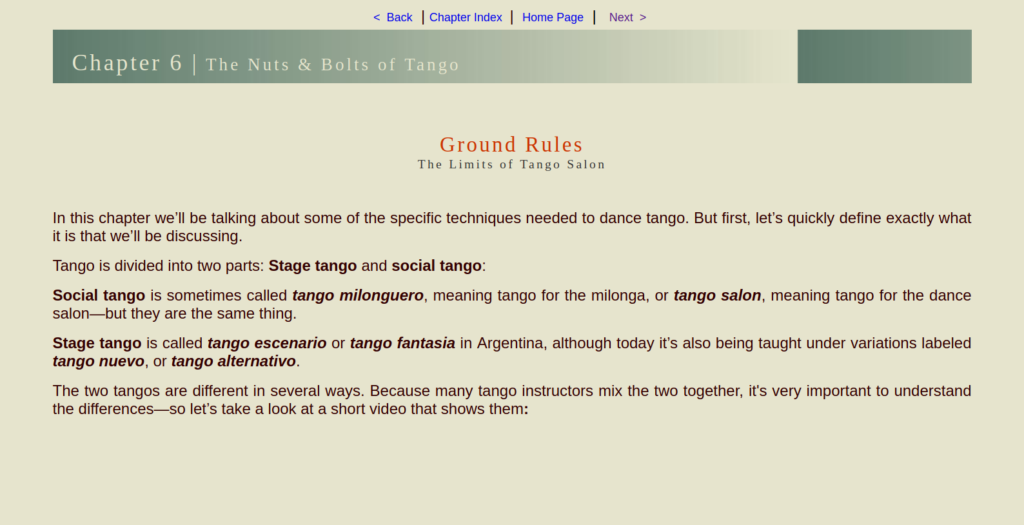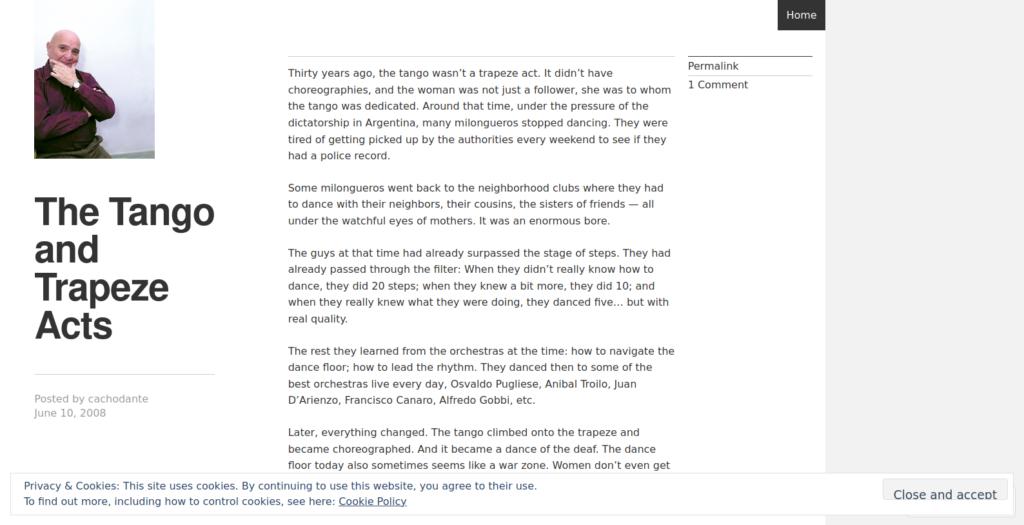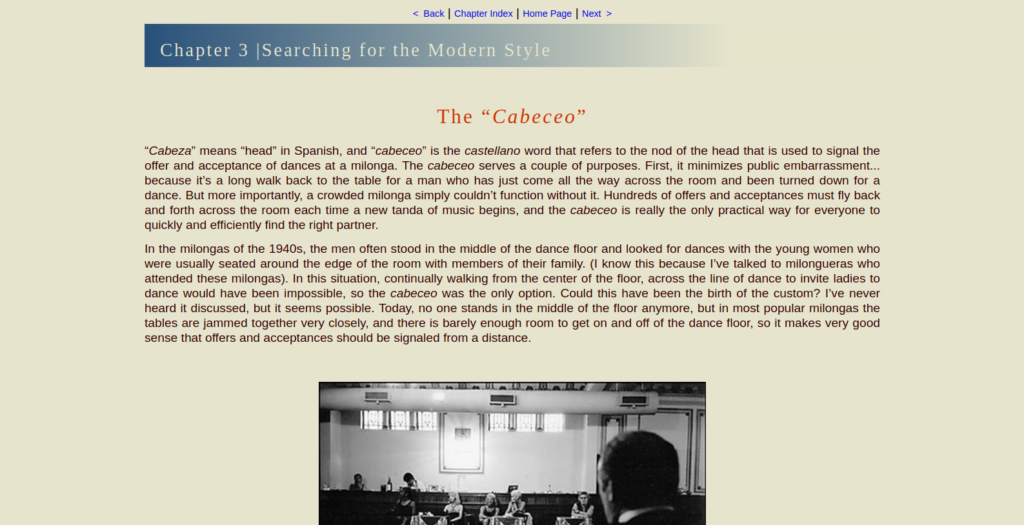
They say being out “in the nature” without understanding it is like being in a museum where all pictures are hanged faced towards the wall.
I don’t remember who was the wise person who said that, but I get the point: without understanding we are destined to see just the surface of things. It’s like looking at their shapes and forms without truly having a grasp of their meaning and the content.
Many people come to tango without being properly introduced in the meaning of what it’s all about and many feel need to find it (because we are meaning searching animals). They try to find it or, if they can’t, they create it.
I am talking here about the meaning of all things we do in tango: the codigos and why they are set the way they are; the embrace and what’s the purpose behind it; the milonga and why is like it is and not any other way… I am talking here about everything about and around tango.
Tango evolution
There’s nothing wrong when people add their meaning to things we do in tango – in fact that is enriching for the dancers and for the dance itself. On the other hand, when people are never exposed to and can’t understand the original meaning of the tango culture, there’s something which is lost. In a way it becomes something else, something which is not tango anymore, but a hybrid.
“But wait Ivica, it’s normal for things to evolve, you might say.
Yes, things evolve – the only thing that is permanent in this world is the change. The problem is that in order for something to evolve it has to first exist. How can a tango culture that never existed in dancing communities around the world evolve. It didn’t existed – so it can’t evolve. We are not talking about evolution here.
It would be a completely different picture if we had educated communities and dancers where people understood why we do certain things in tango and why they are done in a certain way. Than, I’m quite sure, things would evolve in a different way than they did.
I’m fully aware that the tango culture was never one unified phenomena: even in the Golden Age there were varieties and specifics, but that doesn’t mean that teachers are free of obligation to teach it. You can’t just dump bunch of steps and techniques to people who never had contact with tango (except Hollywood movies) and say, they now know how to dance.
There’s something more to know apart from learning how to do pivots or ochos. It’s not a sport. …and even in sports you don’t just give a ball to kids and tell them you have to run and to kick it – you have to tell them that the purpose of all that running and kicking is to get the ball between goal posts.
Well, the idea why these articles are so important is exactly that – they can tell you what’s the point. They can tell kids (let’s use this football analogy) that the point is not to just run and kick the ball, the point is to get it between those white posts we call goals.
Here you can read my notes and the extracted lessons I learned from these 5 articles, but I highly recommend you to read them by yourself as well and extract your own lessons…
1. The origin story

“Clichés about Tango Origins of the Dance” by Christine Denniston
The article starts with busting the cliche that tango was created in brothels of Buenos Aires, but that is not the most valuable lesson one can learn from this.
Of course, it’s interesting fact and it can explain the corny obsession with cheap tango fashion which is favored by tango show dancers. Like they’re trying to sell us this fake origin story of tango as the dance of the prostitutes. There’s nothing in tango that suggest that woman who dances should dress like a prostitute from the wake of 20th century Buenos Aires.
The lesson I want to turn your attention to is the one about why tango was invented in the first place? And, also who invented it?
We have quite unnatural situation in tango today. In the beginning there was lack of women and that was the driving force behind the development of tango. Today the opposite is the true: it is the men who are in deficit and women that are in abundance.
The fact that tango was created as a gift that a man gives to a woman, and that in it’s core it has something that appeals to the heart of the woman – is the exact reason today women are majority. Since in the world we live in there is no lack of women like in Buenos Aires when tango was created, there is no incentive for men to “invest” in learning tango to attract a woman. So, the social motivation for men to learn tango today is out of the picture. At least it’s not in the picture for most of men.
What we are left with is “the pleasure of the dance itself”, the most superficial part – the movement. That part, has to do with showing ones abilities, showing off to other people, competing; and unfortunately the ego. This doesn’t mean that “the pleasure of the dance” is not genuine or that it was never part of the tango – it just means that when decoupled from the social incentive explained above, it often cripples tango and makes it passionless caricature of itself.
BTW. you will find in the article another myth busted – that tango was first danced by men between each other!
2. The big lie

“Ground Rules” by Rick McGarry
If the whole debate about tango styles seems too complicated (and unnecessary) to you, than the only thing you should remember is that there are two reasons people dance tango: to socialize (social tango) and to show off (show tango). That’s it!
Of course, the one can go further (as we will see with the next article), but an average folks like you and me don’t really need to know all that. The separation between social and show dancing has impact on our dancing and that’s why I strongly believe every dancer should learn about it.
In fact, if I have to choose one single article that truly transformed my dancing it was this one. It made me aware of the fact that me and those show dancers I admire – we don’t really dance the same dance. Our goals are not the same and what we do should reflect that.
That was the point when I stopped to push myself to do all these crazy-ass super-duper fancy techniques and ganchos, colgadas and back sacadas… things that I don’t really need to know to be able to dance well. And that was the point when I had more time and energy to practice things that are really important (like walk, embrace and simple musicality).
In reality the show tango is on sale branded as “tango salon”. To be honest I don’t really see any difference between what famous performers do on stage and what is being taught at workshops and classes. It’s like teachers are preparing everyone to perform.
I will here go step further and say that it looks to me like it’s a big scam of the tango industry: amaze newbies with crazy acrobatics and then promise them that you will teach them to do that. It is never mentioned to the students that you can dance tango without all that. But learning shiny techniques and steps is hard and takes many years and classes to learn – and that costs money (money that go right in to the pockets of the performers and show professionals).
3. Tango styles

Let me start this part with quoting Tango Voice, because I think it’s a great summary of the article:
“The blurring of distinctions among tango stylistic variations is perceived and publicly stated as accommodating tango diversity, a valued sociopolitical perspective in liberal democratic societies, but this fails to address the issue of the adaptiveness of each tango style to a particular environmental niche and thus does more harm than good in breeding tango harmony.”
I must make a confession to you: the first time I read this article in its entirety was for the purpose of explaining it to you. Before this I was reading different parts of it, as needed. I mean, it’s written in somewhat philosophical way and it cannot be considered the most readable material. On the other hand it’s so useful that I find every paragraph a jewel that can be developed in separate article – in fact, this article is a great outline of a tango book.
The article touches many topics and explains them deeply and with great knowledge. But does an average dancer needs to know all this? In fact, no. You can become a great dancer even without knowing that much details, but there comes a point where one wants to know more and I think this article is a great point to start.
Yes, there will be a moment where you will encounter a debate about the styles and when that moment comes this article will be great reference.
Hey, sorry to interrupt…
Do you like reading my articles? If you do please consider a small contribution to the existence of this blog.
I don’t sell a book or run ads: I share these articles for free. Unfortunately I also have to pay my bills, so if you see value in my work please consider a small donation/gratuity (the same way you tip your favorite bartender).
From my heart to yours!
Ivica
Securely processed via PayPal
4. Getting the point

“The Tango and Trapeze Acts” by Cacho Dante
I’ve quoted parts of this article so many times that I’m sure if you read me regularly it will sound familiar. I believe that every paragraph should be printed out and hanged on the walls of every tango schools out there.
The best part is that it’s short and clear. If the previous article (the one from Tango Voice) had somewhat scientific style and it was not light reading – this one is the opposite, but without losing anything from it’s value. On the other hand, it doesn’t even try to take neutral position: it’s a confession and advice of an experienced dancer from the Golden Age of tango to the rest of us.
Why is it important? Well, as I said, every paragraph is a lesson to be learned, but I think the most valuable one is in the first and the last sentence.
“…the woman was not just a follower, she was to whom the tango was dedicated”, says Cacho at the beginning.
And then, after all things he explains, he finishes with a direct message to the men in tango:
“Guys, to dance tango, you must listen to the heart of the woman.”
Yes, that’s the point of dancing tango. Understand that and use it in your dancing, and you learn everything. The steps are the easy part, the main is to make her feel like a woman for at least 10 minute on the dance floor.
5. “Gender neutral” cabeceo

“The ‘Cabeceo'” by Rick McGarry
I know many who think that the tango in general is macho dominated environment where women are just a passive objects. Watching what is going on in some of the tango communities I had chance to visit I can agree with this assessment, but I don’t think that the reason for this are the rules. If the milonga becomes macho dominated environment it’s not because of tango – it is because the culture in the society is like that in general.
The rules (codigos) in tango are there to “discipline” the bullies and ego-tripping dancers and allow smooth functioning. If there were no defined rules – the rules are being defined by those without consideration about others.
Let’s take the cabeceo/mirada rule. It makes the woman equally active participant in the game of invitations, giving her opportunity to reject or choose – even to active pursue the dancers she wants to dance with. Unfortunately this part of the tango culture is almost never being taught. In some cases it’s been misrepresented as the part of the problem.
During his/her tango journey the dancer will encounter different codigos in different environments, and of course, one must sometimes be flexible, but I believe that this article is a great starting point to understand the rules of tango.
There is a part in the article which also explain the power-games people play at milongas; and that is present not only in Buenos Aires, but everywhere you go. To be honest, this is my least favorite part of tango, but a dancer must be aware of it and how the codigos can help him/her navigate these games.

Thank you for remembering me.
Excellent article Ivica!